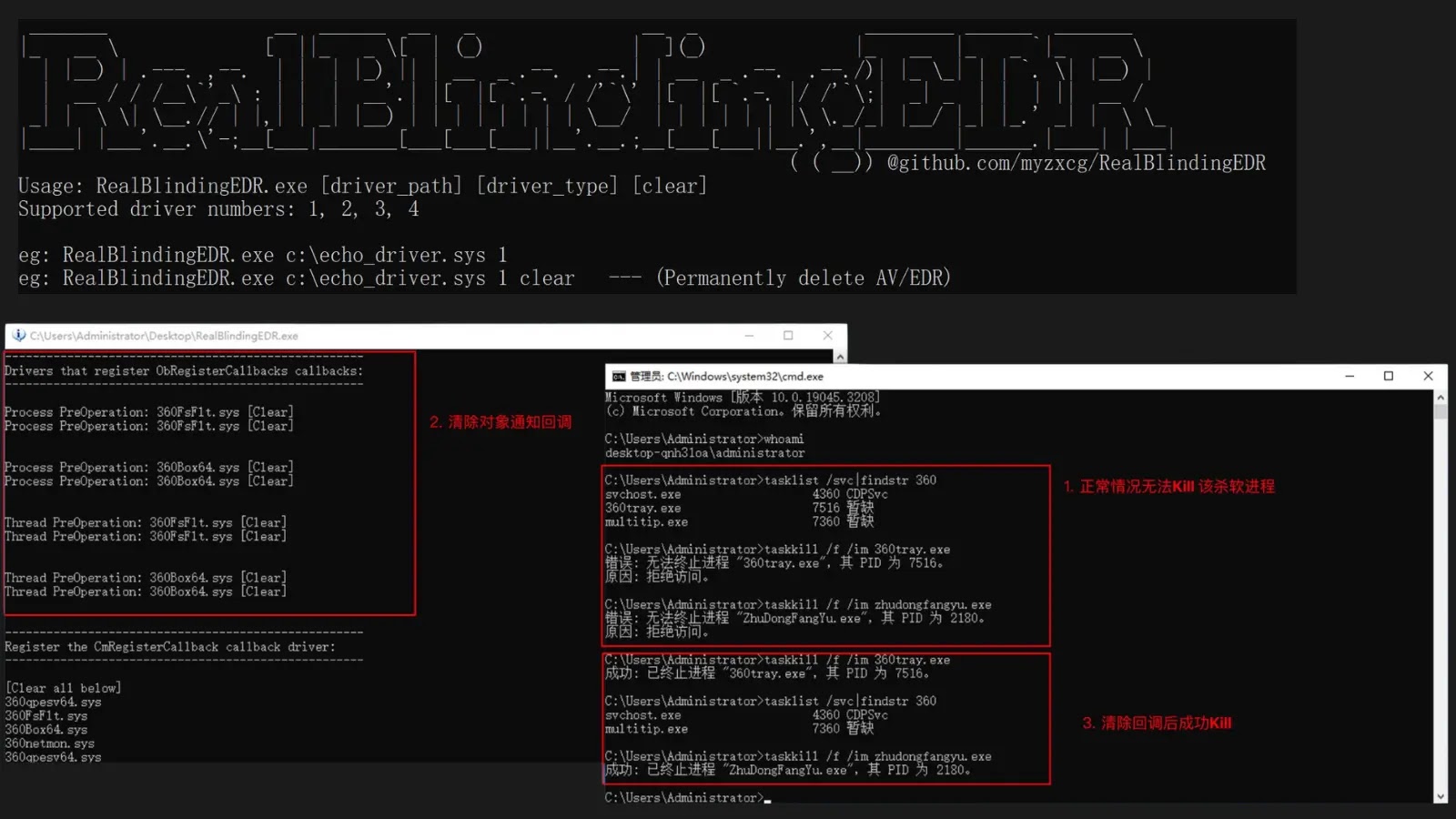
RealBlindingEDR Tool That kills or Permanently Turn off AV/EDR Using Kernel Callbacks
The Blinding Truth: How RealBlindingEDR Sidesteps Endpoint Security
Endpoint Detection and Response (EDR) and Antivirus (AV) solutions form the cornerstone of modern cybersecurity defenses, acting as the last line against sophisticated threats. But what happens when an attacker can simply turn them off? A new open-source utility, RealBlindingEDR, has raised significant concerns within the security community by demonstrating a potent method to effectively blind, permanently disable, or even terminate these critical security applications on Windows systems. This analysis delves into the technical mechanisms of RealBlindingEDR and outlines essential remediation strategies.
Understanding RealBlindingEDR’s Attack Vector
Released on GitHub in late 2023, RealBlindingEDR represents a significant threat. Its primary mechanism involves manipulating kernel callbacks – a fundamental architectural feature of the Windows operating system. Kernel callbacks allow security software and other legitimate applications to register functions that are executed when specific events occur within the kernel, such as process creation, driver loading, or file system activity. By clearing or modifying these critical callback routines, RealBlindingEDR effectively removes the visibility and control AV/EDR solutions rely upon.
The tool achieves its objective by leveraging signed drivers. This is a crucial element, as signed drivers are trusted by the Windows operating system, allowing them to perform privileged operations, including arbitrary memory read and write operations, directly within the kernel space. This capability allows RealBlindingEDR to bypass robust operating system protections like PatchGuard, which is designed to prevent unauthorized modifications to the Windows kernel.
RealBlindingEDR targets at least six known critical kernel callbacks, effectively neutering the ability of security software to monitor or intervene in malicious activities. This includes callbacks related to:
- Process and thread creation/termination
- Image loading (e.g., loading DLLs or executables)
- Registry modifications
- File system operations
By removing these hooks, an attacker can operate with impunity, executing malware, establishing persistence, and exfiltrating data without being detected or blocked by the compromised endpoint security software.
The Role of Signed Drivers and Kernel Access
The reliance on signed drivers is what gives RealBlindingEDR its power. In many instances, these are legitimate, albeit vulnerable, drivers that are repurposed for malicious activities. The ability to load signed drivers, even if they are known to have security flaws (sometimes referred to as “Bring Your Own Vulnerable Driver” or BYOVD attacks), grants an attacker the necessary privileges to interact directly with the Windows kernel. This low-level access is what allows RealBlindingEDR to perform its memory manipulation to clear kernel callbacks, effectively bypassing higher-level security controls.
The implications of such kernel-level access are profound. Once kernel callbacks are disabled, the EDR agent essentially becomes a ghost process on the system, unable to report or react to malicious behavior. This creates a critical blind spot for security teams, potentially allowing sustained and undetected adversary presence.
Remediation Actions
Defending against tools like RealBlindingEDR requires a multi-layered approach focusing on preventing kernel-level compromise and detecting anomalies. Organizations should prioritize the following actions:
- Implement Strong Driver Signing Policies: Restrict the loading of unsigned or untrusted drivers. Leverage Windows Defender Application Control (WDAC) or similar technologies to enforce strict policies on what drivers can be loaded. Regularly audit and update driver allow-lists.
- Patch Management and Vulnerability Remediation: Proactively identify and patch known vulnerable drivers that could be abused in BYOVD attacks. Tools like Microsoft’s HVCI (Hypervisor-Protected Code Integrity) can help prevent the loading of known vulnerable drivers.
- Enhanced Memory and Kernel Monitoring: Deploy advanced EDR solutions that incorporate kernel-level integrity checking and memory forensics capabilities. Look for solutions that can detect unauthorized modifications to kernel structures or callback lists, even if the primary EDR agent is partially compromised.
- Behavioral Analytics and Anomaly Detection: Focus on detecting post-exploitation activities that would occur after an EDR solution is blinded. This includes unusual process behavior, network connections, data exfiltration attempts, or privilege escalation. An EDR that fails silently should still be observable through other means.
- Least Privilege and Attack Surface Reduction: Minimize the privileges of user accounts and applications. Implement strict network segmentation and micro-segmentation to limit lateral movement potential even if an endpoint is compromised.
- Regular Auditing and Integrity Checks: Periodically audit system integrity, including checking for unauthorized driver installations or modifications to critical system components.
Tools for Detection and Mitigation
Effective defense against kernel-level attacks often involves specialized tools and continuous monitoring:
| Tool Name | Purpose | Link |
|---|---|---|
| Sysmon | Comprehensive system activity logging, including driver loads and process creation. | https://learn.microsoft.com/en-us/sysinternals/downloads/sysmon |
| Windows Defender Application Control (WDAC) | Configurable code integrity policies to restrict unsigned or untrusted drivers/applications. | https://learn.microsoft.com/en-us/windows/security/application-security/application-control/windows-defender-application-control/wdac-design-guide |
| Volatility Framework | Memory forensics for analyzing kernel structures and detecting anomalies in memory. | https://www.volatilityfoundation.org/ |
| Microsoft HVCI (Hypervisor-Protected Code Integrity) | Leverages virtualization-based security to protect against vulnerable drivers. | https://learn.microsoft.com/en-us/windows-hardware/design/device-experiences/oem-vbs |
Conclusion
The emergence of tools like RealBlindingEDR underscores the persistent cat-and-mouse game in cybersecurity. By directly targeting kernel callbacks, attackers aim to dismantle the very foundations of endpoint security. Organizations must recognize the gravity of such attacks and invest in robust, multi-layered defenses that go beyond traditional signatures. Focusing on driver trust, kernel integrity, and behavioral anomaly detection will be paramount in maintaining visibility and control against these increasingly sophisticated threats. The ability to detect and respond to attacks that aim to blind security tools is no longer a luxury but a critical requirement for resilient cybersecurity.





